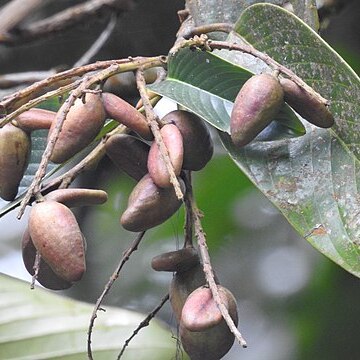Buttressed evergreen trees. Branchlets terete, light to dark-brown, their tips enclosed by caducous, convolute stipules. Stipules finely lengthwise veined, usually with colleters at the base inside, leaving large scars. Leaves spiral, coriaceous, entire, midrib and nerves prominent on both sides, with distinct crossbar veins; petiole terete or slightly furrowed above, long, knee-like thickened at the upper end underneath. Racemes solitary or paired. Panicles axillary, sometimes crowded at the tips of twigs sustained by stipules only and pseudoterminal (B. paniculata), but a terminal bud always present between them. Pedicels with an articulation. Bracts small, caducous. Flowers 5-merous, occasionally some flowers 4-merous, whitish to greenish, fragrant. Calyx deeply lobed, lobes imbricate, sometimes ± valvate. Petals contorted. Stamens inserted on the disk or just beneath the outer margin; anthers lengthwise dehiscent, introrse, latrorse or extrorse, basifixed, obtuse or short-apiculate; cells free for the lower ½-⅔. Disk fleshy, subentire or lobed, glabrous, sometimes puberulous (B. robusta). Ovary free, usually with a tuft of hairs at the top, 2-celled; styles 2, filiform, free or slightly united at the base; stigma small. Ovules 2 in each cell, erect, anatropous. Capsule entire or 2-lobed, 1-2-celled, lengthwise dehiscing loculicidally by 2 valves or on one side, mostly 1-2-seeded. Seeds completely or partly covered by the fleshy aril; albumen abundant, fleshy; cotyledons linear-oblong.
More
Evergreen trees with buttressed trunks, glabrous. Leaves alternate, entire, lateral veins parallel; petiole geniculate; stipules ovate or lanceolate, membranous, stipular scar conspicuous. Inflorescences axillary, cymose, paniculate, or racemose. Flowers bisexual, 5-merous. Disk fleshy, cupular to plate-form, 5-lobed, intrastaminal; anthers longitudinally dehiscent, introrse. Ovary 2-locular, glabrous or apically pubescent; ovules erect, 2 per locule. Capsule 2-valved or fusiform, leathery, loculicidally dehiscent. Seeds 1 or 2, oblong; aril basal or enveloping seed.

